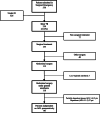Prediction of functional loss in emergency surgery is possible with a simple frailty screening tool
- PMID: 33736667
- PMCID: PMC7977323
- DOI: 10.1186/s13017-021-00356-1
Prediction of functional loss in emergency surgery is possible with a simple frailty screening tool
Abstract
Background: Senior adults fear postoperative loss of independence the most, and this might represent an additional burden for families and society. The number of geriatric patients admitted to the emergency room requiring an urgent surgical treatment is rising, and the presence of frailty is the main risk factor for postoperative morbidity and functional decline. Frailty assessment in the busy emergency setting is challenging. The aim of this study is to verify the effectiveness of a very simple five-item frailty screening tool, the Flemish version of the Triage Risk Screening Tool (fTRST), in predicting functional loss after emergency surgery among senior adults who were found to be independent before surgery.
Methods: All consecutive individuals aged 70 years and older who were independent (activity of daily living (ADL) score ≥5) and were admitted to the emergency surgery unit with an urgent need for abdominal surgery between December 2015 and May 2016 were prospectively included in the study. On admission, individuals were screened using the fTRST and additional metrics such as the age-adjusted Charlson Comorbidity Index (CACI) and the ASA score. Thirty- and 90-day complications and postoperative decline in the ADL score where recorded. Regression analysis was performed to identify preoperative predictors of functional loss.
Results: Seventy-eight patients entered the study. Thirty-day mortality rate was 12.8% (10/78), and the 90-day overall mortality was 15.4% (12/78). One in every four patients (17/68) experienced a significant functional loss at 30-day follow-up. At 90-day follow-up, only 3/17 patients recovered, 2 patients died, and 12 remained permanently dependent. On the regression analysis, a statistically significant correlation with functional loss was found for fTRST, CACI, and age≥85 years old both at 30 and 90 days after surgery. fTRST≥2 showed the highest effectiveness in predicting functional loss at 90 days with AUC 72 and OR 6.93 (95% CI 1.71-28.05). The institutionalization rate with the need to discharge patients to a healthcare facility was 7.6% (5/66); all of them had a fTRST≥2.
Conclusion: fTRST is an easy and effective tool to predict the risk of a postoperative functional decline and nursing home admission in the emergency setting.
Keywords: Emergency surgery; Flemish version of Triage Risk Screening Tool; Frailty assessment; Functional decline; Functional outcome.
Conflict of interest statement
The authors declare that they have competing interests.
References
MeSH terms
LinkOut - more resources
Full Text Sources
Other Literature Sources


